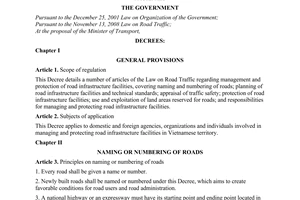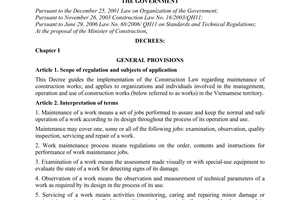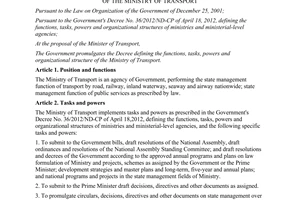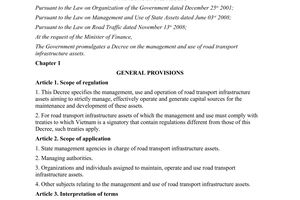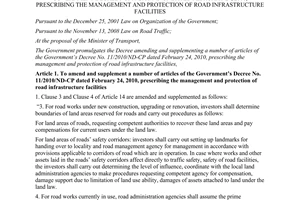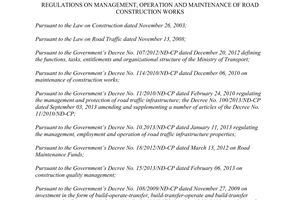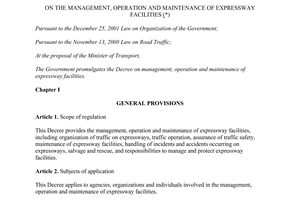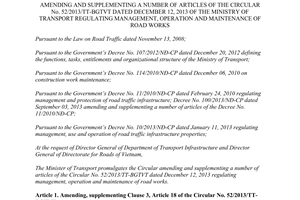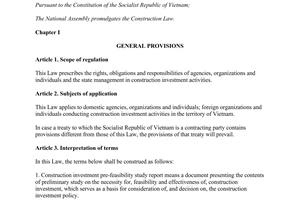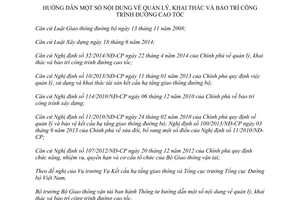Nội dung toàn văn Circular No. 90/2014/TT-BGTVT management operation and maintenance of highways
|
THE
MINISTRY OF TRANSPORT |
SOCIALIST
REPUBLIC OF VIETNAM |
|
No.: 90/2014/TT-BGTVT |
Hanoi, December 31, 2014 |
CIRCULAR
PROVIDING GUIDANCE ON MANAGEMENT, OPERATION AND MAINTENANCE OF HIGHWAYS
Pursuant to the Law on Road Traffic dated November 13, 2008;
Pursuant to the Law on Construction dated June 18, 2014;
Pursuant to 32/2014/NĐ-CP dated April 22, 2014 on management, operation and maintenance of highways;
Pursuant to the Government’s Decree No. 10/2013/NĐ-CP dated January 11, 2013 on management, use and operation of road traffic infrastructure properties;
Pursuant to the Government’s Decree No. 114/2010/NĐ-CP dated December 06, 2010 on construction maintenance;
Pursuant to the Government’s Decree No. 11/2010/NĐ-CP dated February 24, 2010 on management and protection of road traffic infrastructure; the Government’s Decree No. 100/2013/NĐ-CP dated September 03, 2013 amending and supplementing a number of articles of the Decree No. 11/2010/NĐ-CP;
Pursuant to the Government’s Decree No. 107/2012/NĐ-CP dated December 20, 2012 defining the functions, tasks, entitlements and organizational structure of the Ministry of Transport;;
At the request of Director General of Department of Transport Infrastructure and Director General of Directorate for Roads of Vietnam;
The Minister of Transport promulgates the Circular providing guidance on management, operation and maintenance of highways;
Chapter I
GENERAL PROVISIONS
Article 1. Scope and regulated entities
1. This Circular provides guidance on management, operation and maintenance of highways.
2. This Circular applies to organizations, individuals relating to management, operation and maintenance of highways.
Article 2. Interpretation of terms
In this Circular, some terms are construed as follows:
1. Highway management agency includes Directorate for Roads of Vietnam, professional agency affiliated to People’s committees of central-affiliated cities and provinces.
2. Organizations that invest in the construction, management, operation and maintenance of highway works (hereinafter referred to as the Investor) mean organizations, individuals that carry out activities of investment, construction, management, operation and maintenance of highway works.
3. Organizations that are assigned the tasks of operation and maintenance of highways (hereinafter referred to as the operation and maintenance organization) mean entities that are directly involved in operation and maintenance of highway works, bearing responsibilities, obligations and interests under a contract signed with the highway management agency or with the Investor.
4. Road patrol means activities of daily patrol and inspection to oversee the implementation of the plans of traffic organization, traffic safety and protection of infrastructure of highways by the operation and maintenance organizations and individuals assigned the duties.
Article 3. Requirements for management, operation and maintenance of highways
1. Any highway works to be put into operation and use must be managed, operated and maintained according to the Law on Road Traffic, the Government’s Decree No. 32/2014/NĐ-CP dated April 22, 2014 on management, operation and maintenance of highways (hereinafter referred to as the Decree No. 32/2014/NĐ-CP) the Government’s Decree No. 11/2010/NĐ-CP dated February 24, 2010 on management and protection of road traffic infrastructure (hereinafter referred to as the Decree No. 11/2010/NĐ-CP) the Government’s Decree No. 100/2013/NĐ-CP dated September 03, 2013 amending and supplementing a number of articles of the Decree No. 11/2010/NĐ-CP (hereinafter referred to as the Decree No. 100/2013/NĐ-CP) the Government’s Decree No. 114/2010/NĐ-CP dated December 06, 2010 regulating construction maintenance (hereinafter referred to as the Decree No. 114/2010/NĐ-CP) Government’s Decree No. 10/2013/NĐ-CP dated January 11, 2013 on management, use and operation of road traffic infrastructure properties (hereinafter referred to as the Decree No. 10/2013/NĐ-CP) relevant legal documents and provisions set out hereof.
2. Management, operation and maintenance of highways must be done in accordance with the process of operation and maintenance, technical regulations and standards of management, operation and maintenance of highways issued by competent agencies.
3. The process of operation and maintenance of highway works must be formed in accordance with components , equipment installed to the Works, type and grade and purposes of the Works and must be clearly presented in Vietnamese on paper, magnetic disks or other media;
Article 4. Responsibilities of organizations, individuals for management, operation and maintenance of highway works
1. Responsibilities of Directorate for Roads of Vietnam
a) Act as an advisor for the Minister of Transport in carrying out state management function in management, operation and maintenance of highways across the country;
a) Act as an advisor for the Minister of Transport in carrying out state management function in management, operation and maintenance of highways across the country;
c) Handle within their competence or propose competent state agencies to handle any organization or individual who violates management, operation and maintenance of highway works as regulated;
d) Fulfill responsibilities and authorities for overseeing and implementation of the contract during the operation phase with respect to highway projects invested, constructed, managed and operated in the form of public and private partnership under the decentralization and authorization by the Ministry of Transport;
dd) Fulfill responsibilities and authorities of the highway management agency for management, operation and maintenance of highway works within assigned scope;
e) Work out and report to the Ministry of Transport on management, use, operation, maintenance and protection of highway infrastructure across the country as regulated;
g) Instruct highway management departments and road management departments to manage, operate and maintain highway works under the decentralization of Directorate for Roads of Vietnam;
h) Fulfill responsibilities and authorities for management, operation and maintenance of highway works as regulated;
2. Responsibilities of professional agencies affiliated to People’s committees of central-affiliated cities and provinces;
a) Fulfill responsibilities and authorities of the highway management agency for management, operation and maintenance of highways under management of local authority according to the regulations of People’s committees of central-affiliated cities and provinces;
b) Report to People’s committees of central-affiliated cities and provinces, Directorate for Roads of Vietnam on the management, operation and maintenance of highway works within management as regulated;
3. Responsibilities of the Investor:
a) Be responsible to the highway management agency and competent agencies for management, operation and maintenance of highway works under its own management; ensure safety and smoothness of traffic in accordance with the law and the contract;
b) Comply with the investigation and inspection of competent agencies in accordance with the law;
c) Cooperate with central, local functional agencies in propagating, disseminating and educating and executing law regulations on protection of infrastructure and assurance of traffic safety on highways;
d) Report to competent state agencies, highway management agencies on the management, operation and maintenance of highway works under its own management as regulated;
4. Responsibilities of operation & maintenance agencies:
a) Directly implement management, operation and maintenance of highways assigned under this Circular, technical regulations and standards of maintenance, process of operation and maintenance of the works, contracts signed with highway management agency, investor and other relevant regulations;
b) Implement highway patrol as regulated;
c) Cooperate with central, local functional agencies in propagating, disseminating and educating and executing law regulations on protection of infrastructure and assurance of traffic safety on highways;
d) Report to highway management agencies, investor on the management, operation and maintenance of highway works as regulated;
Chapter II
MANAGEMENT AND OPERATION OF HIGHWAY WORKS
Article 5. Subject matters of the management and operation of highway works
Formulation and management of highway works management documents; announcement about putting the Works into operation, temporary suspension of the Works; organization of traffic on highways; management of properties and protection of highway infrastructure; appraisal of traffic safety; management of information on highways; road patrol; handling of accidents and incidents on highways;
Article 6. Highway works management documents
1. Highway works management documents include:
a) Legal documents, inspection records relating to the investment and construction project, documents of completion on the works and putting it into operation;
b) As-built drawings;
c) User manuals and user guides for equipment system, technology line installed to the works;
d) Documents about right of way benchmarks, site clearance benchmarks; certificate of land use right of infrastructure works serving the management of highway works; highway safety corridor benchmarks;
dd) Traffic safety assessment documents (in case traffic safety assessment is required);
e) Process of operation and maintenance of the works;
g) Traffic organization documents;
h) Documents about initial conditions of special bridge, tunnel and floor works;
i) Environmental protection documents;
k) Daily records of road patrols, records of bridges, tunnels, road registration, topographical map; statistical documents about operation of highway works; tapes, discs of conditions of the works and other recording materials;
l) Reports and written records of handling of administrative violations concerning land intended for highways;
m) Documents about inspection, assessment, monitoring, repair, operation and maintenance of highway works;
n) Traffic count data on highways, flows of traffic;
2. Responsibilities for establishing, providing and receiving documents serving the operation and maintenance of highway works during initial phase of investment and construction:
a) As for highway works that are constructed, renovated, upgraded or expanded by state budget sources, the investor shall be responsible for establishing and handing over adequate documents as prescribed in Points a, b, c, d, dd, e, g, h, i, Clause 1 of this Article to the highway management agency before the works has been put into operation;
b) The investor shall establish and file documents itself as prescribed in Point a of this Clause for the highways under its management;
c) As for highway works that are in operation, the operation & maintenance agency shall be responsible for establishing the documents as prescribed in the Points k, l, m, n, Clause 1 of this Article and be subject to inspection by the highway management agency and the investor.
Article 7. Public announcement of putting highway works into operation
1. Before putting the highway works (constructed, renovated or upgraded) into operation, the investor shall establish the documents and make formal request to competent agencies for consideration and putting the works into operation as follows:
a) The Ministry of Transport shall make public announcement for central-managed highway works;
b) The People’s committees of central-affiliated cities and provinces shall make public announcement for local-managed highway works.
2. Request documents for putting highway works into operation
d) The investor submits a set of request documents direct, by post or via any manner as appropriate to competent agencies for handling as prescribed in Clause 1 of this Article. The request documents include:
a) A formal statement for putting the works into operation according to the form shown in the Appendix 1 enclosed herewith;
b) Reports on traffic safety appraisal (in case of projects in need of safety assessment);
c) Approved traffic safety plan
3. Competent agencies receive, examine and handle as follows:
If the documents are found inadequate as required, within two working days at the latest since receipt of the documents, the investor shall be notified in writing to make supplements for completion.
Within three working days since receipt of adequate documents as required, the competent agency shall make public announcement about putting the works into operation if the documents are found eligible and adequate as required. Otherwise, the competent agency shall issue a written notice with reasons stated.
4. As for highway construction projects invested by the Ministry of Transport, People’s committees of central-affiliated cities and provinces, the agencies, organizations that are appointed to use capital sources for the investment and construction of the works shall be responsible for establishing request documents for public announcement about putting the works into operation as prescribed in Clause 2 of this Article and making submission to the Ministry of Transport and People’s committees of central-affiliated cities and provinces for decision.
Article 8. Temporary suspension from operation of highways in special circumstances
1. Highways are put into temporary suspension from operation when a serious traffic accident or works failures result in blockage in either or both ways of highways, affecting usual traffic organization and traffic safety:
The operation & maintenance organization and the investor shall immediately carry out special traffic plans and report to the highway management agency. In case the highway is supposed to be temporarily suspended for 24 hours, a report must be made to the Ministry of Transport and People’s committees of central-affiliated cities and provinces for approval.
2. In case the highway is supposed to be temporarily suspended to serve requirements for national defense and security, the operation & maintenance organization shall carry out approved special traffic plans at the request of competent state agencies.
Article 9. Highway traffic organization plan
Highway traffic organization plan includes:
1. Vehicles eligible for traveling on highways;
2. Using lanes of highways involves normal circulation, lane switching, turning in case of emergency; passing a tollbooth, weight stations; having incidents, accidents and in special circumstances;
3. List of intersections and special works;
4. Allowed speed and safety distance between vehicles;
5. Position, time and duration of lighting;
6. Name, position and conditions for using halting-places, bus-stops, tollbooths and weight stations;
7. Regulations on traffic safety warnings in the implementation of management and maintenance;
8. Emergency phone numbers;
9. Relief and rescue plans;
10. Information communicated via smart traffic system: positions of accidents, incidents, events, weather conditions, construction site, restricted areas, traffic rules, journey consultancy and other issues;
11. Other information: toll collection method and technology; weight station; name and address of agencies, organizations relating to management and operation;
12. Special traffic organization;
Article 10. Sequence and procedures for establishment and approval of highway traffic organization plan
1. Establishment and submission of traffic organization plan:
The investor shall be responsible for establishing traffic organization plan and making submission to competent agencies for review and approval before putting the works into operation.
2. Powers to approve highway traffic organization plan
a) The Ministry of Transport shall approve central-managed highway traffic organization plan at the request of the investor after receipt of the appraisal report from Directorate for Roads of Vietnam.
b) The People’s committees of central-affiliated cities and provinces shall approve local-managed traffic organization plan after receipt of the appraisal report from affiliated professional agencies and agreement from the Ministry of Transport.
3. Request documents for approval of traffic organization plan
The investor submits two (02) sets of request documents directly, by post or any manner as appropriate to competent agencies for handling as regulated in Clause 2 of this Article The request documents include:
a) A formal statement for approval (original) according to the form shown in the Appendix 2 enclosed herewith;
b) Traffic organization plan;
c) Written records of inspection for acceptance and putting the works into operation.
4. Competent agencies receive, examine and handle as follows:
Competent agencies receive and handle the documents. If the documents are found inadequate as required, within two working days at the latest since receipt of the documents, the investor shall be notified in writing to make supplements for completion;
Competent agencies shall assign the highway management agency to carry out appraisal of documents. Time limit for appraisal must be within five working days since receipt of adequate documents as regulated. Within three working days receipt of the appraisal report, upon finding it satisfactory, the competent agency shall carry out approval of the traffic organization plan. Otherwise, the competent agency shall issue a written notice with reasons stated.
5. As for highway construction projects invested by the Ministry of Transport, People’s committees of central-affiliated cities and provinces, agencies, organizations that are appointed to use capital sources for the investment and construction of the works shall be responsible for establishing request documents for public announcement about putting the works into operation as prescribed in Clause 3 of this Article and making submission to the Ministry of Transport and People’s committees of central-affiliated cities and provinces for approval.
Article 11. Monitor and update conditions of damage, degradation of highway works
1. Responsibilities of the investor and highway management agency:
a) Examine fulfillment of responsibilities by operation & maintenance agencies;
b) Carry out regular, unregular inspection and assessment of conditions of damage and degradation of the works;
c) Update and summarize conditions of damage of the works within scope of management for the construction of annual maintenance plan, remedy the damage to ensure safety and smoothness of traffic, or make the report to competent agency with respect to the works managed by the Ministry of Transport.
2. Responsibilities of operation & maintenance agencies:
a) Regularly monitor and update quality conditions of the works, detect signs of damage, degradation of the works assigned;
b) Make monthly, quarterly or unregular reports to the investor or highway management agency, competent state agencies on conditions of damage, degradation of the works assigned.
c) Perform other undertakings according to technical standards of highway management.
Article 12. Management and protection of highway infrastructure
1. Responsibilities of highway management agency:
a) Organize patrol of highways according to the regulations on patrol set out in the Circular No. 47/2012/TT-BGTVT dated November 12, 2012 of the Minister of Transport regulating patrol, inspection and protection of road traffic infrastructure;
b) Execute regulations on management and protection of highway infrastructure according to provisions set out in the Decree No. 11/2010/NĐ-CP Decree No. 100/2013/NĐ-CP and relevant law provisions; carry out floods, storms prevention and fighting tasks as stipulated hereof and relevant law provisions;
c) Examine and oversee the investor, operation & maintenance organizations executing applicable regulations;
2. Responsibilities of the Investor:
a) Examine and oversee the tasks of protecting highway infrastructure carried out by the operation & maintenance organization;
b) Actively cooperate with functional agencies, local authorities in preventing and handling prohibited acts as prescribed in Clauses 1, 2, 3, Article 8 and Clause 2, Article 35 of the Law on Road Traffic and violations of the regulations on management and protection of road traffic infrastructure;
c) Fulfill responsibilities as regulated for highway management agency as prescribed in Point b, Clause 1 of this Article with respect to highway works under its management; Be responsible for reporting results of management and operation of the works to highway management agency as regulated;
3. Responsibilities of operation & maintenance agencies:
a) Organize road patrol, examine and protect highway infrastructure;
b) Execute other regulations on management and protection of highway works according to provisions set out in the Law on Road Traffic, the Decree No. 11/2010/NĐ-CP Decree No. 100/2013/NĐ-CP and relevant law provisions;
c) Execute management and protection of highway works according to technical regulations and standards of highway management and contracts signed with highway management agency and the investor;
d) Carry out floods, storms prevention and control, remedial work;
Article 13. Highway patrol
1. Responsibilities of operation & maintenance agencies:
a) Establish patrol plan corresponding to route conditions;
b) Implement highway patrol as regulated;
c) Handle violations, accidents and incidents within competence in a timely manner;
d) Make the report and formal request to highway management agency, the investor and relevant functional agencies for handling or supporting to handle violations, accidents and incidents beyond competence;
dd) Make the report on road patrol performance, traffic safety and violations of highway infrastructure protection as regulated;
2. Responsibilities of road patrol personnel:
a) Detect and make early report on any abnormality or problem of the works that may affect traffic safety, violations of traffic safety and traffic organization plan, traffic accidents and incidents;
b) Highway works:
Work out to grasp details (quantity, position, conditions...) in each assigned section of the highway works; carry out regular inspection to detect damage, encroachment on the works; make the report to the operation & maintenance organization for early handling measures;
In case the damage is not significant and remedial work does not require equipment or materials, remedial work may be done by patrol personnel themselves or maintenance workers may be asked to do it immediately;
In case any damage that needs to be informed to road users for awareness, warning must be made upon detection and the operation & maintenance organization must be reported to for early handling measure.
c) Traffic circulation on highways:
Detect traffic violations and cooperate with competent agencies in handling and carrying out early remedial work;
Detect positions where traffic congestion is likely to occur, direct traffic and make immediate report to the operation & maintenance organization for handling with respect to cases beyond competence;
Upon detecting traffic accidents, initial information must be reported immediately to the operation & maintenance organization for informing other relevant agencies; carry out first-aids and have accident victims transported; protect the site; direct traffic while police is yet to come; hand over the site and cooperate guidance and direction of traffic;
Monitor construction works carried out on highways in operation; request the construction contractor to comply with traffic safety assurance plan during construction; detect and cooperate in handling acts of causing loss of traffic safety within competence; immediately report to the operation & maintenance for handling with respect to cases beyond competence;
d) Detect and report violations concerning management and protection of highway lands to highway operation & maintenance organization;
dd) Highway safety corridor
Work out and clearly understand site clearance benchmarks, right-of-way benchmarks, current conditions of safety corridor range of the managed section of highway;
Detect violations of the regulations on management and protection of highway safety corridor; establish written records and make the report to the operation & maintenance organization;
e) Record road patrol results in patrol dairy; store and protect road patrol documents;
3. Requirements for road patrol personnel:
a) Obtain degrees in roads and bridges from trade schools; pass training in professional competence in highway patrol; pass training in first-aids; understand the law; be able to disseminate, guide and interpret the law on road traffic;
b) When performing duties, patrol staff must wear reflective uniforms attached with name tags of the operation & maintenance organization and names of patrol staff themselves;
c) When performing duties, a team of road patrol must consist of at least two staff. One makes the warnings and the other carries out professional competence.
4. Highway patrol tasks conducted in specialized cars, motorbikes On road patrol vehicles, in addition to specialized equipment as regulated, medical equipment serving first-aids is also required.
Article 14. Controlling overload, oversize vehicles traveling on highways
1. Determination of loads on highways is carried out through a specialized scale; Results of examination of vehicular load, vehicle axle load shall be used to determine current conditions and overload level and shall be reported to functional agencies for handling as regulated.
2. Examination of dimensional limits on highways is carried out by specialized equipment at the entrance of highways.
3. Any vehicle that violates regulations on vehicular loads, dimensional limits of bridges, roads must be moved out of the highway range for remedial work and handling according to law provisions. The operation & maintenance organization has the right to reject to serve overload, oversize vehicles and at the same time cooperate with competent agencies for early handling.
Article 15. Fixed information on highways
1. Fixed information is provided via a road signaling system on highways.
2. Regulations and installation of the road signaling system on highways must conform to National technical regulation on highway signals, road signals and regulations of the Ministry of Transport.
3. Highway signaling system must conform to the approved highway traffic organization plan, providing to road users information about related road network, courses, directions at intersections, entrance and exit of highways, warnings about accidents, service system along highways.
Article 16. Changeable information on highways
1. Changeable information is the information that may change by time including weather, traffic density, information about courses, accidents, incidents, temporary suspension of operation and other information relating to traffic on highways.
2. Changeable information shall be provided through:
a) Highway signs that are set up in special cases and such highway signs must conform to National technical regulation on road signs and highway signs;
b) Electronic information signs on highways and such signs must conform to applicable regulations on electronic information signs on highways;
c) Information supply points on highways such as halting-places, service stations and other information supply places;
d) Radio waves with frequency permitted by competent agencies;
dd) Electronic information pages of the highway management agency;
e) Commands from traffic conductors on highways while carrying out maintenance or handling accidents or incidents on highways;
Article 17. Regional traffic management center
1. Regional traffic management center shall be responsible for overseeing and managing activities of route-based traffic management centers and traffic management centers in the area within management.
2. Responsibilities of regional traffic management center
a) Collect, handle and manage information reported by route-based traffic management centers for the purposes of supervision and management ensuring traffic safety on highway routes within scope of management;
b) Directly instruct operation & maintenance organizations in the area to support the handling of accidents, incidents and serious cases. Supervise supply of information from route-based traffic management centers during relief, rescue operation;
c) Regulate traffic on highways according to special traffic organization plans approved by competent agencies in case of emergency, natural disasters or national security;
d) Distribute information to route-based traffic management centers for regulation of traffic aimed at preventing congestion on highways and roads in the area;
dd) Perform patrol on highways as assigned to investigate and supervise the implementation of road patrol; handle or cooperate in handling violations within competence;
e) Provide to road users information about courses and traffic conditions, restricted operation of other routes in the area via electronic signs, radio waves, television, digital maps and other information supply services;
g) Manage and store data concerning highway traffic circulation in the area serving the management of planning and constructing the highway development and operation plan undertaken by the highway management agency.
3. Regional traffic management centers in the area must be connected to one another for sharing information, have an equal and cooperative relationship.
Article 18. Route-based traffic management center
1. Route-based traffic management centers are under the supervision and management of regional traffic management centers; shall be responsible for operating the traffic management system on a particular highway.
2. Responsibilities of route-based traffic management center
a) Collect and handle traffic information on a particular highway route including images caught on camera, vehicle tracking data, weather conditions, detection of accidents, incidents, events and traffic violations committed by road users;
b) Supervise and manage information relating to occurrence of events on highways resulting in congestion, accidents, incidents and dangerous weather conditions as well as planned events such as location of construction works, special ceremonies;
c) Provide to road users changeable information including weather conditions, traffic density, information about courses, accidents, incidents, temporary suspension of operation and other information relating to traffic circulation on highways;
d) Receive and perform early handling of information relating to accidents, vehicle problems, works problems on highways reported from all sources of information in order to immediately mobilize road patrol forces, traffic responders and make the notification to police agencies, relief and rescue teams, and other relevant forces for early presence and action;
dd) Store all information on highway routes under applicable regulations for all types of documents; Permanently store electronic information relating to accidents, incidents; As for regular electronic information, storage shall depend on nature of information, data to meet management targets as regulated. Electronic documents must be stored in an appropriate environment and transferred via an appropriate technology;
e) Actively take remote control measures to ensure traffic safety such as regulating traffic lanes or restricting vehicle speed to a level appropriate for real-life circumstance;
g) Collect, store and manage concentrated traffic data from tollbooths and vehicle load control system on highways;
h) Connect and transmit sufficient traffic information, data to regional traffic management centers;
i) Receive and supply information, carry out special traffic organization plans under direct instruction of regional traffic management center in case of emergency;
k) Monitor the maintenance of equipment that belongs to highway traffic monitoring and management system;
Article 19. Connection between regional traffic management centers and route-based traffic management centers
1. Information exchanged between regional traffic management centers and route-based traffic management centers includes images caught on camera, weather, vehicle identification data, traffic events, traffic instruction and other information on request.
2. Connection and exchange of information, data between regional traffic management centers and route-based traffic management centers are carried out in accordance with technical regulations and standards issued by competent agencies.
Article 20. Operation process of works, facilities on highways
1. All the works must be accompanied by an operation process:
a) Swing bridge, bridges that use overhead lifting equipment, suspension bridges, cable-stayed bridges, continuous beam bridges from grade I and over, any bridge that uses complicated structure and technology;
b) Tunnels that use equipment serving management and operation of the works;
c) Technological equipment installed at tollbooths;
d) Technological equipment installed at weigh stations;
dd) Smart traffic monitoring system, traffic control technological equipment;
e) Other cases as regulated by competent state agencies, investors or owners of the works;
2. Operation process of the works on highways includes guidelines given by design consultants, regulations issued by facilities & technology suppliers on methods, sequence of operation and employment of the works, on equipment installed to the works to ensure proper operation of the works that then brings about safety and longevity of the works and equipment as designed.
3. Content of operation process of the works on highways must generally include regulations on traffic organization, operated loads, vehicle speed, vehicle components, lane arrangement, sequential operation of the equipment installed to the works, regulations on relief, rescue, fire & explosion safety and other relevant issues.
4. Responsibilities for establishment, assessment, approval and revision of operation process are the same as responsibilities for highway works maintenance process.
5. Bases for the establishment of operation process include:
a) Design documents;
b) Uses, capacity, characteristics and nature of equipment installed to the works;
c) Handbooks, user manuals, operator’s instruction of equipment and the works;
d) Regulations on traffic safety assurance, labor safety and environmental protection;
dd) Other issues the same as for highway works maintenance process;
Chapter III
HIGHWAY WORKS MAINTENANCE
Article 21. Content of highway works maintenance
1. Highway works maintenance includes all the tasks to ensure and maintain normal and safe operation of the works according to design during the operation. Content of highway works maintenance includes inspection, monitoring, quality appraisal, regular care and repair of the works, environmental protection.
2. Inspection, monitoring, quality appraisal, regular care and repair of highway works shall be carried out in accordance with the Circular No. 52/2013/TT-BGTVT dated December 12, 2013 of the Minister of Transport regulating management, operation and maintenance of road construction works and the Circular No. 20/2014/TT-BGTVT dated May 30, 2014 amending and supplementing a number of articles of the Circular No. 52/2013/TT-BGTVT.
Article 22. Responsibilities and bases for establishment of highway works maintenance process
Responsibilities and bases for the establishment of highway construction works maintenance process shall be regulated as in the case of road construction works maintenance process as instructed Articles 6, 7 of the Circular No. 52/2013/TT-BGTVT.
Article 23. Assessment and approval of highway works maintenance process
1. As for highway construction projects, the assessment and approval of the maintenance process are instructed in Article 7 of the Circular No. 114/2010/NĐ-CP.
2. As for the works that are put into operation but yet accompanied by a maintenance process, responsibilities for assessment and approval are as follows:
a) The Ministry of Transport, People’s committees of central-affiliated cities and provinces shall organize assessment and approval of highway construction works maintenance process within scope of management;
b) The investor shall organize assessment and approval of highway works maintenance process with respect to the works of its own after reaching an agreement with competent state agencies.
3. Agencies that are responsible for approving the maintenance process may hire consultant to assess part or whole of the process before approval.
Article 24. Revision of highway works maintenance process
During the implementation, upon finding any factor that affects safety, operation capability, quality and longevity of highway works, the highway management agency, owner of the highway works shall instruct revision of the maintenance process and make the submission to competent agencies as prescribed in Clause 2, Article 23 hereof for approval.
Article 25. Implementation of highway works maintenance process
Implementation of highway construction works maintenance process shall be regulated as in the case of road construction works maintenance process as instructed in Articles 18, 19, 20, 21, 22, 23, 24, and 25 of the Circular No. 52/2013/TT-BGTVT.
Article 26. Traffic safety assurance plan during maintenance on highways in operation
1. Traffic safety assurance plan during the maintenance on highways in operation shall conform to not only the provisions set out in the Decree No. 11/2010/NĐ-CP but also the following provisions:
a) Facilities, equipment owned by construction contractors:
It is required to attach name tags, yellow flashing warning lights, a “vehicle is working” reflective notice in front, at the back and on two sides of the equipment;
Facilities, equipment are only allowed to move and work within the construction site.
b) Personnel in charge of maintenance task:
Construction workers are required to wear reflective protective clothing, shoes and caps;
Construction inspectors are required to wear reflective uniforms, protective shoes and caps;
Such personnel are only allowed to work within the construction site;
Any staff who fails to meet the requirements shall be forced out of the site by functional forces or patrol teams.
c) Notice or warnings about the scope of construction site must be made before and during the construction period on highways and must be communicated to road users in advance.
d) Any maintenance task that requires low-speed moving equipment must be performed at daytime without visibility restrictions. During the implementation, a warning vehicle with warning instruments adequately installed on it must be used, moving the same direction, speed and lane as the maintenance vehicle and keeping a distance of 100 meters from the maintenance vehicle in the opposite direction unless the specialized vehicles used for highways are installed with traffic safety warning devices.
2. As for regular repair work:
a) The traffic safety assurance plan must be included in design documents and submitted to competent agencies for approval as regulated;
b) The highway management agency shall approve the traffic safety assurance plan with respect to highways directly assigned to the operation & maintenance organization;
c) The investor shall approve the traffic safety assurance plan with respect to highways under its management and operation and notify the result to the highway management agency;
Article 27. Responsibilities of organizations, individuals for ensuring traffic safety during maintenance on highways in operation
1. Directorate for Roads of Vietnam shall organize investigation and inspection of the implementation of traffic safety assurance during the maintenance on highways in operation across the country;
2. Directorate for Roads of Vietnam, professional agency affiliated to People’s committees of central-affiliated cities and provinces shall:
a) Inspect and monitor the implementation of traffic safety assurance measures during the maintenance period and the compliance with the provisions set out in the highway construction license within scope of management;
b) Temporarily or permanently suspend the construction upon detection of violations or failures to fulfill traffic safety assurance measures as regulated;
c) Cooperate with functional forces in organizing the implementation of traffic safety assurance plan
3. Responsibilities of the Investor:
a) Inspect the implementation of traffic safety assurance tasks conducted by the operation & maintenance organization within scope of management;
b) Cooperate with functional forces in organizing the implementation of traffic safety assurance plan;
4. Responsibilities of operation & maintenance agencies:
a) Establish the traffic safety assurance plan during the maintenance on highways and make submission to the highway management agency or the investor for approval before commencement of construction;
b) Carry out the approved traffic safety assurance plan;
c) Provide information about maintenance plan to regional traffic management centers, route-based traffic management centers and road users via mass media.
Chapter IV
IMPLEMENTATION
Article 28. Transitional provision
As for highway construction projects that have been put into operation under temporary regulations of the Ministry of Transport, People’s committees of central-affiliated cities and provinces, highway management agencies, the investor shall carry out checking, supplementing and fulfilling all the requirements for management, operation and maintenance of the works according to the provisions set out hereof and must complete it until 31, 2015 at the latest.
Article 29. Effect
This Circular takes effect since March 01, 2015.
Article 30. Responsibilities
1. Chief of the Ministry Office, the Chief Inspector, director generals of Directorate for Roads of Vietnam, Director General of the Vietnam Register, directors of the Services of Transport of central-affiliated cities and provinces, heads of relevant agencies, organizations and individuals shall be responsible for executing this Circular./.
2. Difficulties that arise during the implementation of this Circular should be reported (by relevant organizations, individuals) to Directorate for Roads of Vietnam for instructions or to the Ministry of Transport for consideration and handling./.
|
|
THE MINISTER |
------------------------------------------------------------------------------------------------------
This translation is made by LawSoft and
for reference purposes only. Its copyright is owned by LawSoft
and protected under Clause 2, Article 14 of the Law on Intellectual Property.Your comments are always welcomed

